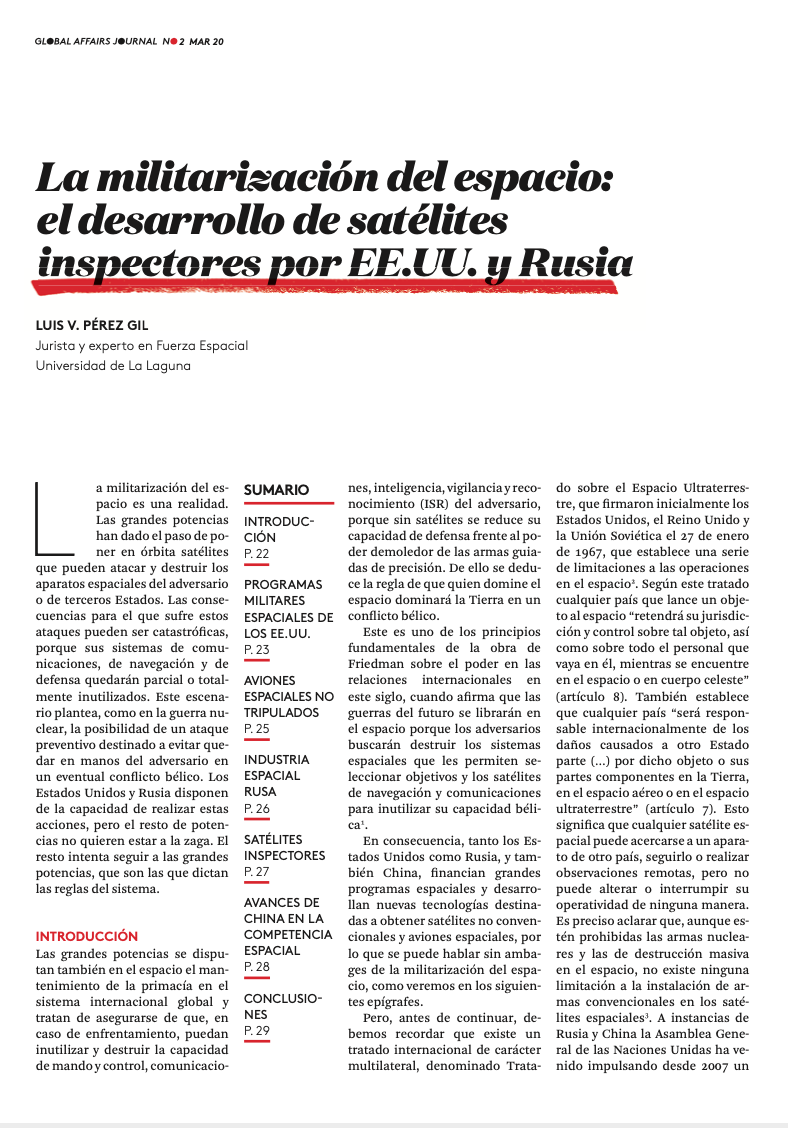Ruta de navegación
Menú de navegación
Blogs
Entries with label Killer Satellites .
![US X-37B unmanned space plane returning from its fourth mission in 2017 [US Air Force]. US X-37B unmanned space plane returning from its fourth mission in 2017 [US Air Force].](/documents/10174/16849987/gaj-foto-2.jpg)
▲ US X-37B unmanned space plane, returning from its fourth mission, in 2017 [US Air Force].
GLOBAL AFFAIRS JOURNAL / Luis V. Pérez Gil
 [10-page document. downloadin PDF]
[10-page document. downloadin PDF]
INTRODUCTION
The militarisation of space is a reality. The major powers have taken the step of putting satellites into orbit that can attack and destroy the space apparatus of adversary or third states. The consequences for the victim of such attacks can be catastrophic, because its communications, navigation and defence systems will be partially or totally disabled. This scenario raises, as in nuclear war, the possibility of a pre-emptive strike aimed at avoiding falling into the hands of the adversary in an eventual war. The United States and Russia have the capability to take such action, but the other powers do not want to lag behind. The rest are trying to follow the great powers, who dictate the rules of the system.
In space, too, the great powers are competing to maintain their primacy in the global international system and seek to ensure that, in the event of a confrontation, they can disable and destroy their adversary's command and control, communications, intelligence, surveillance and reconnaissance (ISR) capabilities, because without satellites their ability to defend themselves against the devastating power of precision-guided weapons is reduced. From this follows the rule that whoever dominates space will dominate the Earth in a war.
This is one of the fundamental tenets of Friedman's work on power at International Office in this century, when he argues that the wars of the future will be fought in space because adversaries will seek to destroy the space systems that allow them to select targets and the navigation and communications satellites to disable their war-fighting capabilities.
As a result, both the United States and Russia, as well as China, are funding major space programmes and developing new technologies aimed at obtaining unconventional satellites and space planes, so that we can unambiguously speak of the militarisation of space, as we shall see in the following sections.
But before we continue, we must remember that there is a multilateral international treaty, called the Outer Space Treaty, which was initially signed by the United States, the United Kingdom and the Soviet Union on 27 January 1967, which establishes a series of limitations on operations in space. According to this treaty, any country launching an object into space "shall retain jurisdiction and control over such object, as well as over all staff on it, while in space or on a celestial body" (article 8). It also states that any country "shall be manager internationally liable for damage caused to another State party (...) by such an object or its component parts on Earth, in airspace or in outer space" (article 7). This means that any space satellite can approach, follow or remotely observe another country's apparatus, but cannot alter or interrupt its operation in any way. It should be made clear that while nuclear weapons and weapons of mass destruction are prohibited in space, there is no limitation on the installation of conventional weapons on space satellites. At the urging of Russia and China, the UN General Assembly has been pushing since 2007 for a multilateral treaty banning weapons in outer space, the use of force or the threat of force against space objects, project , but this has been consistently rejected by the United States.
